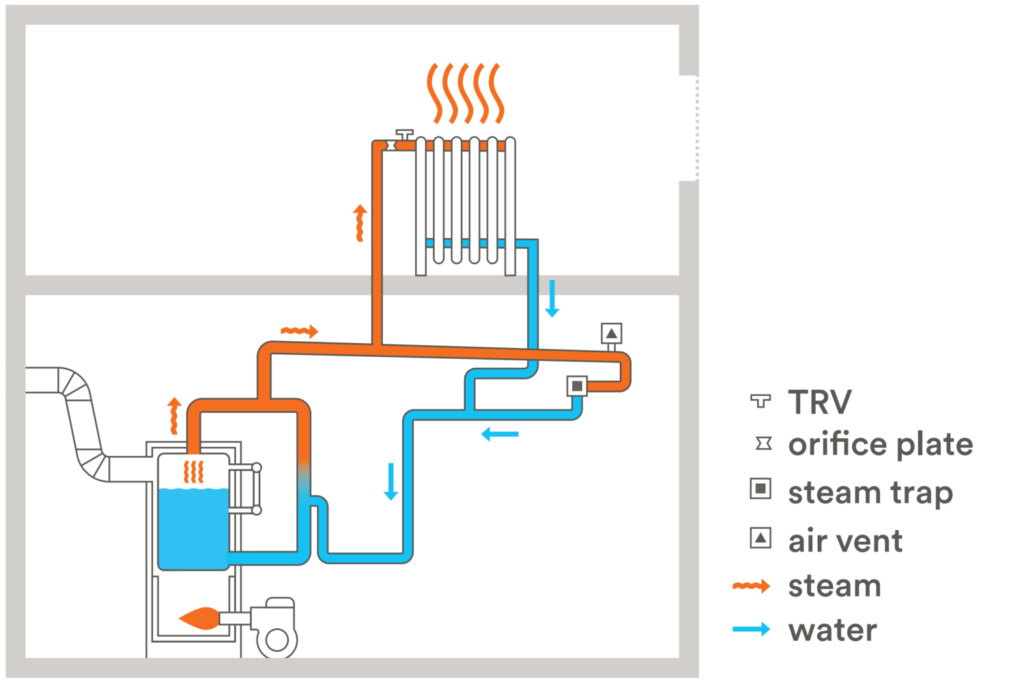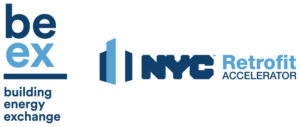Two-Pipe Steam Systems
Simple measures for two-pipe steam systems to enhance efficiency and comfort.
Tech Overview
Applicable Buildings Types hotels, multifamily, commercial
When to Implement anytime
*Be sure to consult a qualified service provider to determine the right measures for your building.
What is a Two-Pipe Steam System?
Two-pipe steam systems distribute steam through a building’s pipes to radiators that heat occupant spaces usually in buildings up to six stories tall. Although two-pipe steam is commonly associated with overheating and energy waste, optimizing these systems with a few high-efficiency upgrades can reduce energy bills, improve resident comfort, and provide efficient, reliable, and balanced heat for years to come.

Fig 1. An optimized two-pipe steam system retrofitted with orifice plates, thermostatic radiator valves (TRVs), and properly sized vents provides efficient and balanced heat.
How to Implement
A two-pipe steam retrofit requires not only tuning and upgrading boilers, but comprehensively improving each radiator, enhancing the distribution, and optimizing controls. High performance is only achieved when the system is addressed as a whole. Download the full tech primer to learn more about each of the following steps:
A. Install Orifice Plates and Thermostatic Radiator Valves to help regulate the flow of steam at each radiator
B. Installing Radiant Barrier Insulation between the radiator and the wall can help block heat from being absorbed into the wall
C. Implementing Master Venting helps flush trapped air quickly and ensures that steam reaches all apartments evenly through high-capacity air vents at the ends of steam mains and on the tops of riser lines
D. Upgrading Controls makes a steam system more responsive to actual heating needs with the help of multi-sensor controls that monitor both outdoor and indoor temperatures
E. Support Staff Training and Maintenance can help achieve energy savings by identifying and addressing maintenance needs independently or engaging qualified contractors
F. Tune Existing Boilers to ensure dry steam for an effective steam system
G. Replace Boilers with new boilers that are correctly sized for the distribution system
Cost and Benefits
Cost and benefits of a two-pipe system retrofit will vary depending on your building’s baseline systems and conditions. Typically, buildings can expect to see the following results:
Greenhouse Gas (GHG) Savings
A comprehensive two-pipe steam upgrade can moderately reduce heating related GHG emissions.
Tenant Experience Improvement
Two-pipe steam retrofits greatly improve tenant satisfaction by offering temperature control and delivering balanced, even heating throughout the building.
Utility Savings
Moderate utility cost savings can be expected from a two-pipe steam retrofit.
Capital Cost
Two-pipe steam upgrades require a moderate upfront capital investment.
Maintenance Requirement
Two-pipe steam systems require a moderate level of maintenance including burner tuning and boiler cleaning to ensure optimal operating efficiency and can easily be done by knowledgeable staff.
Take Action
This information is part of more than a dozen High Performance Technology Primers prepared by the Building Energy Exchange and the Retrofit Accelerator to introduce decision-makers to solutions that can help them save energy and improve comfort in their buildings. Curious about other retrofitting possibilities? Explore our complete library of Tech Primers here.
The NYC Retrofit Accelerator’s team of Efficiency Advisors offers free, personalized advisory services to help streamline the process of making energy efficient improvements to your buildings.
Get in touch with the NYC Retrofit Accelerator today!
Call (212) 656-9202
Visit nyc.gov/RetrofitAccelerator
Email info @nycretrofit.org
